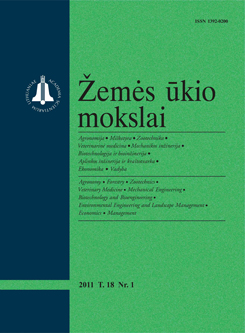 ISSN 1392-0200 |
2008 m. Nr. 4 Influence of crop rotation and catch crop for green manure on nitrogen balance in organic farming
A field experiment was carried out in an organic certified field of the Experimental Station of the Lithuanian University of Agriculture in 2003–2007. The soil type was Calc(ar)i Epihypogleyic Luvisol (LVg-p-w-cc). Nitrogen balance was evaluated after four years of experiment. Four 7-year crop rotations with a different ratio of nitrogen fixing crops were compared: I – 43% (grass‑clover; grass-clover; winter wheat; spring barley; peas; winter wheat; spring barley); II – 43% (grass-clover; winter wheat; peas; spring barley; grass-clover; winter wheat; spring barley); III – 29% (grass-clover; potato; oat; spring barley; peas; winter wheat; spring barley); IV – 14% (grass-clover; winter wheat; potato; spring barley; winter rape; winter wheat; spring barley). The catch crop was (1) included, (2) not included in rotations. The objective of our study was to evaluate the influence of crop rotations with a different nitrogen fixing crop percentage and catch crop (for green manure) on nitrogen balance in organic farming. The least soil nitrogen loss (1.87 to 4.58 kg ha–1) due to leaching to deeper soil horizons was established in crop rotations II and IV, in grass-clover and winter rape crop. The biggest nitrogen loss (40.7 to 74.8 kg ha–1) was found in the soil of crop rotation I in peas and in the soil of crop rotation III in peas without a catch crop. Catch crop for green manure reduced nitrogen leaching by 94.9% in the soil of crop rotation III in comparison with the same crop rotation (III) without a catch crop. The amount of nitrogen leached to the deeper soil layers depended on nitrogen content in the soil. During the experiment, a negative nitrogen balance was established in the soil of all crop rotations (–46.69 to –145.13 kg ha–1). The nitrogen balance was influenced by nitrogen uptake from soil (r = –0.77, P < 0.05). The obtained data show that biological nitrogen suppliers are very important in organic farming. Keywords: nitrogen balance, crop rotation, catch crop, organic farming |
Numeriai:
2012 - T.19 Nr.1 2011 - T.18 Nr.1, Nr.2, Nr.3, Nr.4 2010 - T.17 Nr.1-2, Nr.3-4 2009 - T.16 Nr.1-2, Nr.3-4 2008 - T.15 Nr.1, Nr.2, Nr.3, Nr.4 2007 - T.14 Nr.1, Nr.2, Nr.3, Nr.4, Nr.Priedas 2006 Nr.1, Nr.1.Priedas, Nr.2, Nr.3, Nr.4 2005 Nr.1, Nr.2, Nr.3, Nr.4 2004 Nr.1, Nr.2, Nr.3, Nr.4 2003 Nr.1, Nr.2, Nr.3, Nr.4 2002 Nr.1, Nr.2, Nr.3, Nr.4 2001 Nr.1, Nr.2, Nr.3, Nr.4 |